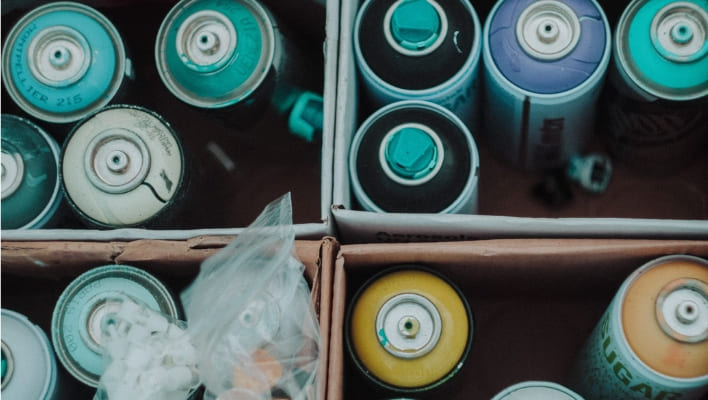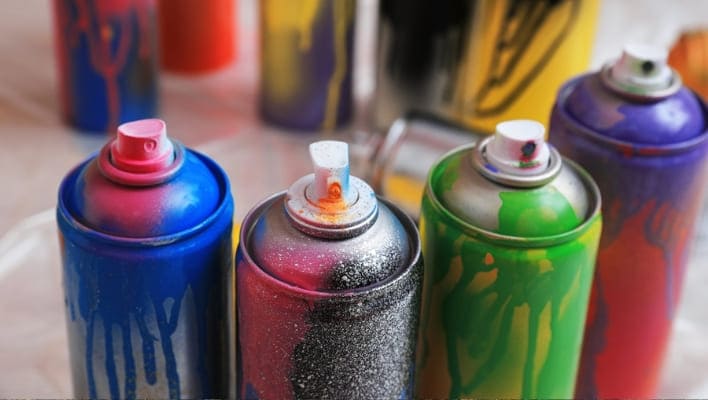Paint sprayers are a great tool to have for any painting project. They make painting faster and easier and produce smoother and more uniform finishes. Even so, it is essential to know how often to clean your paint sprayer properly to keep them proper working condition. A dirty paint sprayer can cause clogs, uneven spraying, and can even damage the equipment. In this article, we will discuss how to clean a paint sprayer with dried paint, cleaning a clogged paint sprayer and much more.
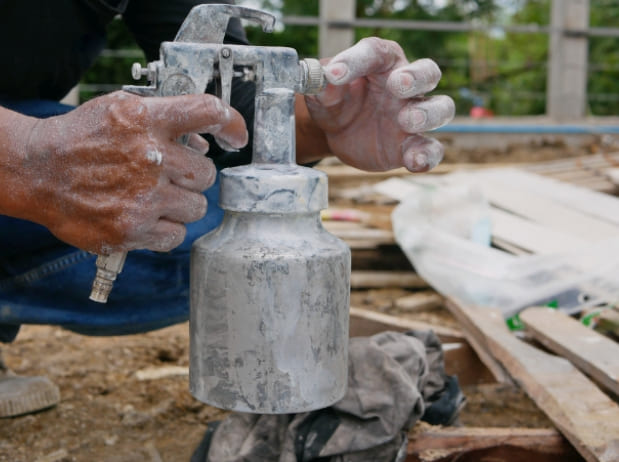
Table of Contents
- How to clean a paint sprayer with dried paint:
- Step By Step Guide For Cleaning The Paint Sprayer
- How long can a paint sprayer sit without being cleaned?
- Short Breaks (under 4 hours):
- Extended Breaks (4-24 hours):
- Long-Term Storage (more than 24 hours):
- How To Clean An Air Paint Sprayer:
- Step 1: Release the pressure
- Step 2: Disassemble the sprayer
- Step 3: Clean the paint container
- Step 4: Use a cleaning solution
- Step 5: Scrub the parts
- Step 6: Rinse & Dry
- Step 7: Lubricate the sprayer
- How to Clean a Clogged Paint Sprayer:
- What is the best thing to clean a paint sprayer with?
- Cleaning A Paint Sprayer With Paint Thinner
- Conclusion On Cleaning A Paint Sprayer:
- FAQS On How To Clean A Paint Sprayer
- Q: Can you run paint thinner through a paint sprayer?
- Q: Can you clean a paint sprayer with soap and water?
- Q: Can I leave paint in the sprayer overnight?
How to clean a paint sprayer with dried paint:
Cleaning a paint spray gun with dried paint can be a bit more challenging, but it is possible with the right tools and techniques. Here are the steps to follow:
Step By Step Guide For Cleaning The Paint Sprayer
Step 1: Turn off and unplug the sprayer
Before starting to clean your paint sprayer, make sure that it is turned off and unplugged to prevent injuries.
Step 2: Disassemble the paint sprayer
Next, remove the tip and filter from the sprayer. These parts are more likely to clog, so they must be thoroughly cleaned.
Step 3: Clean the paint container
Empty the remaining paint from the container and wipe it clean with a rag.
Here’s what I learned from my experience:
When I was painting with my airless Graco Magnum ProX19, the first thing I did was push all the paint out of the machine and clean out the hose. The hose could hold about a quart of paint, so it took a bit of time to get it all out. To prevent anything from drying on the pipes, I wiped them down first. This step was a bit messy, but it was probably the messiest step of the whole process.
To save the leftover paint, I put the return back into the paint and turned the pressure down to low because I didn’t want to splatter paint everywhere. I turned on the machine at low pressure and ran it until the paint coming out was milky in consistency. It wasn’t totally clean, but it was close enough.
Then, we turned off the machine and put the hose into the water to push all the paint out. It was a bit tedious, but it was important to make sure that the hose was clean and ready for the next use.
Step 4: Use a cleaning solution
For cleaning a paint sprayer with dried paint, you need a strong cleaning solution that can dissolve the paint. Alternatively, you can mix water and vinegar in a 1:1 ratio for your own cleaning solution.
Step 5: Soak the sprayer parts
Soak the parts in a cleaning solution: Use an appropriate cleaning solution that is compatible with the paint and solvent you used. Leave the parts to soak for half an hour.
Here’s another lesson I’ve learned. One winter in Canada, I made a mistake of leaving water in the system of my machine whole night. It would cause the pump to rust. When the temperature dropped, the machine froze and I had to spend a lot of money to get it fixed. It was a costly lesson, but now I know better. So, I made sure to clean out the pump holes to avoid any such mishaps in the future.
Step 6: Run the sprayer with the cleaning solution
Fill the paint container with the cleaning solution and run the sprayer for a few seconds. This will flush out any remaining paint from the system.
Step 7: Scrub the sprayer
Scrub the inside of the container and the tip and filter with a cleaning brush. Brush or scrub the small parts with a toothbrush.
Step 8: Rinse the parts
Rinse the parts thoroughly with water and air dry them. Also, make sure all the parts are completely dry, before reassembling the sprayer.

TIP: After rinsing your sprayer with water, flush it once more using mineral spirits or Pump Armor. This adds a protective layer to prevent freezing and corrosion.
If you plan to use the machine frequently with short breaks of just one to three days in between, you can dilute the pump armor with water. Mix it in a one-to-ten ratio, meaning one part armor to nine parts water. However, if you intend to store the machine for an extended period, it’s best to use the pump armor undiluted directly in the machine.
How long can a paint sprayer sit without being cleaned?
A paint sprayer can typically sit without being cleaned for up to 24 hours. However, it’s important to follow these guidelines:
Short Breaks (under 4 hours):
If you plan to take a short break during painting (less than 4 hours), you can often leave the paint in the sprayer. Simply cap it or cover the nozzle to prevent drying.
Extended Breaks (4-24 hours):
If you need to pause for an extended period (between 4-24 hours), it’s best to clean the sprayer. Follow the manufacturer’s instructions for cleaning and storage. Leaving paint in the sprayer for too long can result in clogs or damage.
Long-Term Storage (more than 24 hours):
For longer periods, it’s essential to thoroughly clean the sprayer to prevent any paint residue from drying inside.
How To Clean An Air Paint Sprayer:
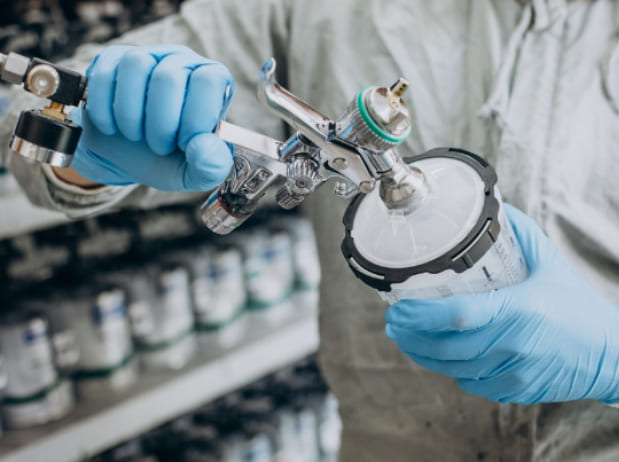
Air paint sprayers are powered by compressed air, which means they require a bit of extra care when it comes to paint sprayer cleaning. Here are the steps to follow:
Step 1: Release the pressure
Before starting to clean your air paint sprayer, you need to release the pressure from the system. To do this, turn off the compressor and disconnect the air hose. You can read the pressure relief method in detail.
Step 2: Disassemble the sprayer
Next, disassemble the sprayer and remove all the parts, including the tip, filter, and air cap. Soak these parts in a cleaning solution to loosen any paint residue.
Step 3: Clean the paint container
Empty the remaining paint from the container and wipe it clean with a rag. Then fill it with the cleaning solution and run the sprayer for a few seconds to flush out any remaining paint.
Step 4: Use a cleaning solution
For cleaning an air paint sprayer, you need a cleaning solution that is specifically designed for these types of sprayers. These solutions are formulated to dissolve paint and clean the internal components of the sprayer.
Step 5: Scrub the parts
Remember to scrub the parts after they soak in the cleaning solution with a brush or toothbrush. Pay extra attention to the small parts, such as the tip and air cap, as they are more prone to clogging.
Step 6: Rinse & Dry
Rinse and dry all the parts before reassembling the sprayer.
Step 7: Lubricate the sprayer
Air paint sprayers have internal components that require lubrication to function properly. Use a few drops of lubricant on the moving parts of the sprayer before reassembling it.
How to Clean a Clogged Paint Sprayer:
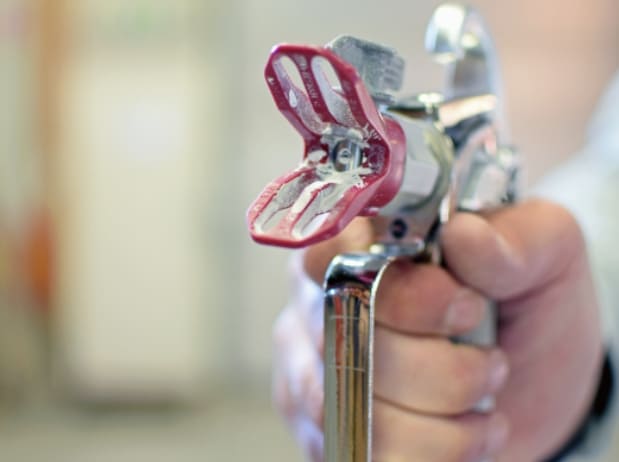
Paint sprayers can become clogged in both air and electric paint sprayers, reducing their effectiveness, output and causing frustration for the user. Here’s how to unclog a paint sprayer:
- To clean a clogged paint sprayer, you’ll need some supplies including a bucket, water, cleaning solution, a brush, and a wrench.
- Before attempting to clean the paint sprayer, you should release any pressure that may be built up inside the sprayer. This can be done by turning off the power, removing the spray tip, and triggering the sprayer until no more paint comes out.
- Remove the spray tip, guard, and other detachable parts.
- Next, disassemble the sprayer by removing the paint cup, suction tube, and spray tip. If your paint sprayer has a filter, remove that as well.
- Insert a cleaning needle or wire into the tip and remove any debris or buildup.
- Use an appropriate cleaning solution (alternatively a solution of warm water and dish soap) and soak the parts for at least an hour to loosen any dried paint.
- Gently scrub off any remaining paint with the help of a brush.
- Once the parts are clean, rinse them off with clean water and let them dry completely.
- After the parts have dried, reassemble the sprayer in the reverse order that you disassembled it.
- Before using the sprayer again, test it by spraying some water or paint onto a scrap piece of material to ensure that the sprayer is working properly.
- Test the sprayer by spraying some water or paint onto a scrap piece of material before using the sprayer again.
What is the best thing to clean a paint sprayer with?
The best thing to clean a paint sprayer with is a dedicated paint sprayer cleaning solution, which you can typically find at home improvement or paint supply stores. These solutions are specifically designed to dissolve paint residues and prevent clogs.
I usually soak the parts in mineral spirits or water; this will help soften any leftover paint stuck in the sprayer. Alternatively, you can wipe them with a rag soaked in water or mineral spirits to remove any remaining paint residue
Cleaning A Paint Sprayer With Paint Thinner
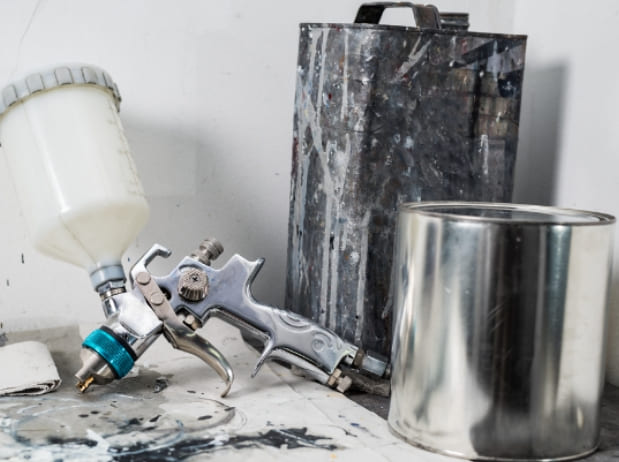
Cleaning a paint sprayer with paint thinner is an essential step to ensure the longevity of your equipment and maintain the quality of your paint jobs. Here is a step-by-step guide on how to clean a paint sprayer with paint thinner:
Materials needed:
- Paint thinner ( usage of paint thinner to remove paint )
- Water
- Bucket
- Cleaning brush or toothbrush
- Protective gloves
- Safety goggles
Step 1: Preparation
Before starting the cleaning process, put on protective gloves and safety goggles. Fill a bucket with a mixture of paint thinner and water (1:3 ratio).
Step 2: Disconnect And Disassemble
Unplug the sprayer and remove the spray tip, nozzle, and other parts that can be detached.
Step 3: Soak The Parts
Place the detachable parts, such as the spray tip and nozzle, into the bucket of paint thinner and water and soak them for about half an hour to dissolve paint.
Step 4: Clean The Sprayer
Using a cleaning brush or toothbrush, scrub the inside of the sprayer and other non-detachable parts with the paint thinner solution. Focus on areas that are prone to paint build-up, such as the intake valve and the filter.
Step 5: Rinse the parts
After the detachable parts have soaked for about 30 minutes, remove them from the bucket and rinse them with water. Use the cleaning brush or toothbrush to remove any remaining debris.
Step 6: Reassemble and test
Once all parts have been cleaned and dried, reassemble the sprayer and test it to ensure it is functioning correctly.
Note: It is important to dispose of the paint thinner and water mixture according to local regulations.
Conclusion On Cleaning A Paint Sprayer:
Cleaning a paint sprayer is an important task that should not be overlooked if you want to keep your equipment in good working condition and ensure the quality of your paint jobs. With proper cleaning and maintenance, your paint sprayer will last longer and provide you with excellent results for many years.
FAQS On How To Clean A Paint Sprayer
Q: Can you run paint thinner through a paint sprayer?
Yes, paint thinner can be sprayed with a paint sprayer. Most people use turpentine or white spirit to clean and maintain their paint sprayers after spraying oil-based paint. You should use a ratio of 1:3. (1 part paint thinner and 3 parts paint). Paint thinner is a solvent that helps dissolve and remove dried paint and other residues from the internal parts of the paint sprayer. This ensures that your sprayer works properly the next time you use it and extends its lifespan.
However, it is important to note that you should only use paint thinner that is specifically recommended for use with your paint sprayer. Using the wrong type of thinner or solvent can damage your sprayer or affect the quality of your paint job.
Q: Can you clean a paint sprayer with soap and water?
Yes, soap and water are usually sufficient for cleaning water-based paints. However, the type of paint you are using will determine the specific cleaning method required.
On the other hand, if you plan to apply oil-based paint or solvent-based paint, you will have to use a specific solvent or paint thinner recommended by the manufacturer. Using soap and water on oil-based paints can actually make the cleaning process more difficult and potentially damage the sprayer.
Q: Can I leave paint in the sprayer overnight?
It is not recommended to leave paint in a sprayer overnight. If paint is left in a sprayer for an extended period, it can dry and clog the sprayer, causing issues with the next use. It is always best to clean the sprayer immediately after use.
However, if you must leave paint in the sprayer overnight, make sure to seal it properly and store it in a cool, dry place. Before using the sprayer again, make sure to check the viscosity of the paint and stir it thoroughly. If the paint has thickened, it may require thinning.

Rosalie Sanchez
DIY enthusiast with years of experience in home decor and home improvement. With a passion for educating consumers about DIY projects. Every time, I work with our painting professionals to provide you with the best painting product reviews and how-to advice. You can follow me on Facebook.

